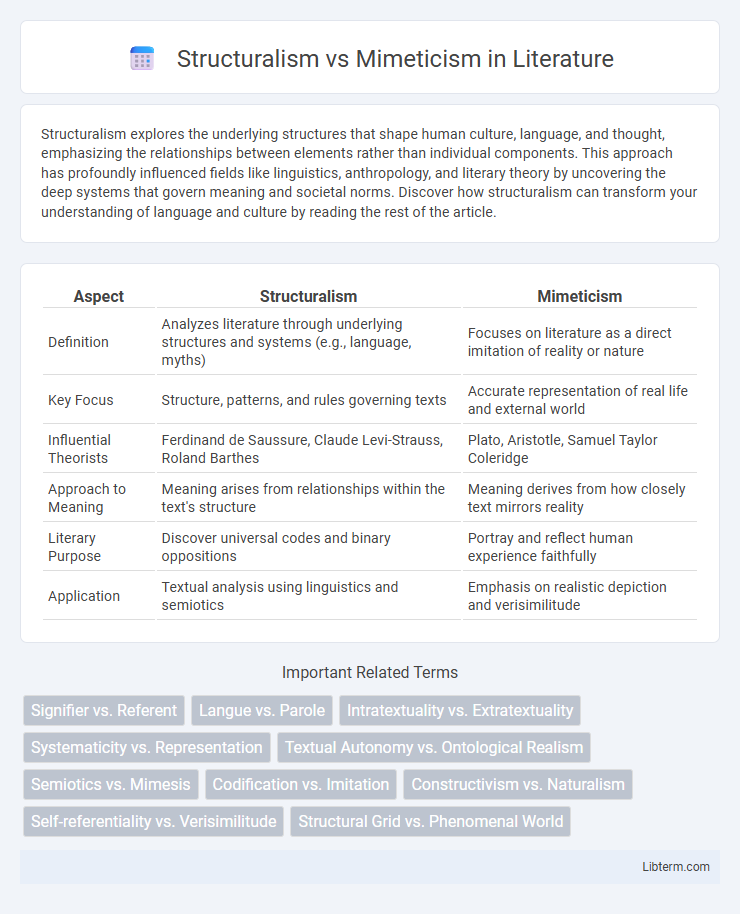Structuralism explores the underlying structures that shape human culture, language, and thought, emphasizing the relationships between elements rather than individual components. This approach has profoundly influenced fields like linguistics, anthropology, and literary theory by uncovering the deep systems that govern meaning and societal norms. Discover how structuralism can transform your understanding of language and culture by reading the rest of the article.
Table of Comparison
| Aspect | Structuralism | Mimeticism |
|---|---|---|
| Definition | Analyzes literature through underlying structures and systems (e.g., language, myths) | Focuses on literature as a direct imitation of reality or nature |
| Key Focus | Structure, patterns, and rules governing texts | Accurate representation of real life and external world |
| Influential Theorists | Ferdinand de Saussure, Claude Levi-Strauss, Roland Barthes | Plato, Aristotle, Samuel Taylor Coleridge |
| Approach to Meaning | Meaning arises from relationships within the text's structure | Meaning derives from how closely text mirrors reality |
| Literary Purpose | Discover universal codes and binary oppositions | Portray and reflect human experience faithfully |
| Application | Textual analysis using linguistics and semiotics | Emphasis on realistic depiction and verisimilitude |
Introduction to Structuralism and Mimeticism
Structuralism emphasizes the underlying systems and relationships that shape cultural phenomena, analyzing literature, language, and society as interconnected structures. Mimeticism focuses on the representation or imitation of reality, asserting that art and literature reflect the external world and human experience. These foundational theories highlight contrasting approaches: Structuralism seeks patterns within frameworks, while Mimeticism prioritizes faithful reproduction of observable life.
Historical Origins and Development
Structuralism emerged in the early 20th century primarily through the work of Ferdinand de Saussure, who emphasized the underlying structures of language and culture as systems of signs shaping meaning. Mimeticism traces its roots to ancient Greek philosophy, notably Plato and Aristotle, highlighting art as an imitation of reality to represent truth and human experience. The development of structuralism expanded through scholars like Claude Levi-Strauss, applying systemic analysis to myths and social structures, while mimetic theories evolved through Renaissance humanism and neoclassical aesthetics focusing on the faithful representation of nature.
Core Principles of Structuralism
Structuralism centers on analyzing underlying structures in cultural phenomena, emphasizing the relationships and functions of elements within a system rather than individual content. It asserts that meaning arises from the interconnections and contrasts between components, such as signs in language or mythology, governed by universal rules. This approach contrasts with Mimeticism, which prioritizes representation and imitation of reality, focusing on accurate depiction rather than abstract structures.
Essential Tenets of Mimeticism
Mimeticism centers on the essential tenet that literature and art serve as imitations of reality, capturing the external world and human experiences with fidelity. It emphasizes representation, suggesting that creative works should mirror life accurately to convey truth and meaning. This approach contrasts with Structuralism's focus on underlying structures and systems that govern texts beyond their surface reflections.
Key Theorists and Foundational Texts
Structuralism, founded by Ferdinand de Saussure and further developed by Claude Levi-Strauss, emphasizes the underlying structures in language and culture, with key texts like Saussure's "Course in General Linguistics" (1916) and Levi-Strauss's "The Savage Mind" (1962). Mimeticism, rooted in Aristotelian philosophy, focuses on art as imitation of life, highlighted in Aristotle's "Poetics," which remains foundational for understanding representation and narrative in literature and art. Both theories shape literary and cultural analysis by prioritizing either abstract structural relations or representational fidelity.
Comparative Analysis: Structuralism vs Mimeticism
Structuralism emphasizes underlying systems and relationships within texts, analyzing how elements function together to create meaning, whereas Mimeticism focuses on the accurate representation of reality and life in literature and art. Structuralism dissects narratives through binary oppositions and deep structures, while Mimeticism prioritizes faithful depiction and reflection of external reality. The comparative analysis reveals Structuralism's abstract, systemic approach contrasts with Mimeticism's realist, representational focus.
Application in Literary Criticism
Structuralism in literary criticism analyzes underlying systems, codes, and relationships within texts to uncover universal patterns and structures that shape meaning. Mimeticism emphasizes the representation of reality, focusing on how literature reflects or imitates real-life experiences, social conditions, and historical contexts. Structuralism aids in understanding narrative techniques and thematic frameworks, while mimeticism evaluates a text's fidelity to external reality and its social or psychological accuracy.
Influence on Modern Art and Culture
Structuralism's emphasis on underlying systems and relationships reshaped modern art by encouraging artists to explore abstract forms and symbolic meanings beyond mere imitation of reality. Mimeticism's focus on accurate representation influenced movements like realism and photorealism, emphasizing precise depiction of subjects that connect viewers to tangible experiences. The dialogue between structuralism's abstract interpretation and mimeticism's faithful reproduction continues to shape contemporary artistic practices and cultural narratives.
Criticisms and Limitations
Structuralism faces criticism for its abstract approach, often neglecting historical and cultural contexts of literary works, limiting its applicability to diverse texts. Mimeticism is criticized for oversimplifying literature by reducing it to mere reflection of reality, ignoring the creative and interpretive aspects of art. Both theories struggle to account for reader response and evolving meanings in texts, highlighting the need for more dynamic frameworks.
Conclusion: Contemporary Relevance
Structuralism and Mimeticism offer distinct frameworks for interpreting texts, with Structuralism emphasizing underlying systems and patterns while Mimeticism focuses on realistic representation. Contemporary relevance lies in Structuralism's ability to decode cultural and linguistic structures shaping meaning, whereas Mimeticism remains crucial for assessing authenticity and social realism in literature and media. Both approaches enrich critical analysis by addressing different dimensions of textual interpretation in modern scholarship.
Structuralism Infographic

 libterm.com
libterm.com